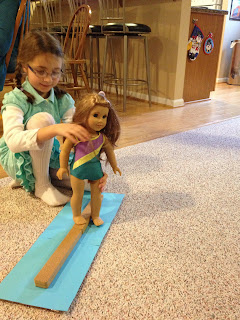Disclaimer: I am an Amazon Associate and iTunes Affiliate and am compensated for sales through Amazon and iTunes links. I appreciate your support of my blog by shopping through my links.
Recently I have had a few Facebook friends and other bloggers share articles from the
Washington Post1 and
the Atlantic2 about changes at American Girl and the emphasis of recent catalogs shifting away from the historical characters.

I am the mother of an American Girl loving 7 year old. My first exposure to American Girl was through her as I was 12 when the first dolls were released. Honestly, I did not even realize that originally the Historical Dolls were the only dolls until we got more interested in American Girl. My daughter received her first doll for Christmas 2011 and saved to buy her second in 2012. (more on this later). I have issues with both articles, particularly the Washington Post article. The Washington Post article implies that the historical girl line is gone:
Forget Samantha the Victorian girl, Molly the plucky World War II doll with the Victory Garden, or original Colonial girl Felicity. Felicity’s been retired to the Upstate Doll Farm. So’s Samantha. Kirsten the pioneer? Gone.2
Many comments that I have read both from Facebook shares and the article's comments from people who grew up with American Girl are not currently familiar with American Girl took this statement to mean that the historical line is gone.
This is simply not true. Yes, American Girl has branched out from the historical girl roots and are not prominently featured in every catalog. Yes, several of the original or early characters have had their dolls and accessories retired. The books, mini-dolls and movies (Felicity & Samantha) for the retired dolls are still available and they are still featured on the website. So, no they have not abandoned the historical dolls. As a matter of fact last fall, they introduced Caroline who lived in upstate New York during the War of 1812 and this spring Molly and Emily received new items in their line - pajamas and a redesigned bed.
American Girl Historical Doll Release & Retirement years with total dolls from the collection with other key company developments
3:
- 1986 - 3 - Molly (1944 Illinois - WWII), Samantha (1904 New York - Edwardian), Kirsten (1856 Minnesota - Pioneer) released
- 1991 - 4 - Felicity (1774 Williamsburg, VA - Pre-Revolutionary War) released
- 1993 - 5 - Addy (1864 Philadelphia - a former Slave) released
- 1995 - American Girl of Today (now My American Girl) released
- 1997 - 6 - Josefina (1824 New Mexico under Mexican rule) released
- 1998 - American Girl Place opens in Chicago & Mattel purchases the company
- 2000 - 7 - Kit (1934 Ohio - Depression)
- 2001 - First Girl of the Year released
- 2002 - 8 - Kaya (1764 Pacific Northwest - Native American) released
- 2004 - 8+1 - Nellie (Samantha's Friend) released
- 2005 - 8+2 - Elizabeth (Felicity's Friend) released
- 2006 - 8+3 - Emily (Molly's Friend) released
- 2007 - 9+4 - Julie & Ivy (1970s) released
- 2008 - 9+5 - Ruthie (Kit's Friend) released
- 2009 - 9+4 - Samantha & Nellie retired, Rebecca released (1914 Immigrants)
- 2010 - 8+4 - Kirsten retired
- 2011 - 9+3 - Felicity & Elizabeth retired, Marie-Grace and Cécile released
- 2012 - 10+3 - Caroline released (1812)
A few things jump out at me, blame is largely placed on Mattel and the corporate, profit drive. the My American Girl dolls which are much disparaged in both articles were released in 1995, 3 years BEFORE Mattel purchased the company. Likewise, the first store was opened about the same time as the sale.
At the current time, there are 13 Historical Dolls Available (10 main dolls and 3 friends). (Marie-Grace and Cécile are both considered co-main characters and share a 6 book series, 3 books with each as the main character.) While there have been 3 main dolls retired, new ones have been added. 10 is the most main characters that they have ever had. They also offer the Girl of the Year doll and a selection of My American Girl dolls so girls can find one that looks like them. The books, movies, and mini-dolls are still available for the original dolls.
One of main contentions from The Atlantic article is that the catalogs and website no longer features the historical dolls in as much detail or with prominence. I disagree on the prominence. There have been at least two catalogs that featured Caroline prominently since her September 2012 release. Similarly, there were several catalogs featuring Marie-Grace and Cécile (New Orleans 1854) when they were released in fall 2011. These catalogs typically feature other historical dolls in the front section.
It seems most of the authors are comparing the catalog of their youth from the late 80's or early 90's when there were 3-5 dolls to today when there are 10 main historical characters plus assorted other characters. It is simply not practical to cover 10 characters in the same detail that was provided when there were only 3-5 characters. Plus, the website is now available for more more information on the characters.
Now, to discuss the website. The Atlantic article discusses the website and the historical dolls:
They are almost an afterthought on the website, where the homepage features matching doll and girl outfits, plus the product line and online game for Saige, the latest Girl of the Year.1
I just went to the American Girl website. I would argue that the home page is little more than a landing page. The main content now is largely generic. While the Shop link highlights Saige (2013 Girl of the Year), the Play tab highlights Kaya's new game.
I selected Play first. Here the Historical Girls are not hidden. As a matter of fact, the historical dolls link is above Girl of the Year or My American Girl. You can select any of the main characters (including the retired Felicity, Samantha, and Kirsten) for more information and to play games related to them. Personally, I'd rather send my daughter to the website to learn about the dolls instead of a catalog. The Play section of the website is separate from the Shop section so they can learn about the history without the "Buy This" message so obviously in their face.
In iOS Apps, there is an app for each doll released since 2011:
Since the apps are available for all dolls released after 2011, I don't have a problem with their being more Girl of the Year apps than Historical doll apps. All of the apps are free except for
Runaway Pup which costs $2.99. My daughter has all of the apps and uses them all.
For the record when my daughter first asked for an American Girl doll, I knew none of the company's history. Until that point, my daughter had expressed no interest in dolls. I was planning to buy her a My American Girl doll, but she was fascinated by the stories that came with the dolls and as a bookworm loved that they came with a book. The two dolls that she wanted were Kanani (2011 Girl of the Year) and Molly (1944, an original which we did not know at the time). She was fascinated with the idea of Kanani being from Hawaii. Plus, she fell in love with the Monk Seal, since Kanani was only available that year, we bought her Kanani and the Monk Seal for Christmas. I'm not sure why she identified with Molly - maybe because of a slight resemblance or because Dad is always watching shows about World War II on the History Channel. She saved the money to buy Molly herself. She now has Molly's friend Emily and McKenna - the 2012 Girl of the Year.
My daughter has 7 complete sets of the Historical Girl books. Before Christmas in 2011, Costco had sets of the books with a mini-doll. At the time, I bought her the Felicity set and my parents bought her Kit. When she loved those, I was upset that I had not bought additional sets. This year when they had the sets, I bought every set that was available where she did not have the books already. Before having the sets, she was routinely checking the books out of the school library.
Last fall as Halloween approached, she decided to be Molly for Halloween. Not just Molly, but Halloween Molly. Of course there is no Molly costume for girls, so we got to make it. Fortunately she already had a red sweater like Molly and we were able to make her own skirt.


I don't see the stores mentioned in the article, but would like to add a few thoughts. First, I live 4 hours from the nearest American Girl store (Chicago) so we have only been once, when my daughter bought Molly. Before we went, I looked at the calendar and saw that an upcoming day had Molly themed activities so we decided to wait for "Molly Day". In looking at the events calendar, they currently have Kit's Imagination Celebration, Kit's Tree House Craft, American Girl Historical Character Scavenger Hunt, Marie-Grace & Cecile's Dance Slipper Craft, Julie's Bracelet Craft, Julie's Seventies Party, Julie's Disco Dance Steps Demo, and Molly's Victory Garden Craft. We did Molly's Victory Garden Craft and the American Girl Historical Character Scavenger Hunt as well as a Molly themed dining event.
The Chicago store is an anchor store of Water Tower Place on two floors. The first floor is street level. When you walk in from the main Michigan Avenue entrance, you encounter the books (with the historic dolls series prominently featured), a small display with the Girl of the Year and proceeding forward is the Historical Girl area. The My American Girl dolls are upstairs (as is the doll salon and cafe) as is the larger display of Girls of the Year.
I also disagree with the disparaging of the issues faced in the Girl of the Year books. In Saige's book, she deals with cuts to the arts program and ways to help. From the Washington Post article:
OH GOD! NOT THE ARTS BUDGET! THAT’S LIKE WORLD WAR II AND SLAVERY ALL ROLLED INTO ONE!2
Yes, it is not on the same scale, but it is a real issue that is being faced in many communities across the country. I guess the author has no problem with slashing arts budgets since it is unimportant on the grand scale. Plus, how can you blame American Girl for tackling a mild issue. A few years ago the Girl of the Year Chrissa was given a friend Gwen who was formerly homeless following her dad leaving, her mom's job loss, and a foreclosure. At the time, American Girl received criticism for this both for both portraying men as unreliable and the cost of a doll depicting the homeless.
The Washington Post article goes on to disparage the Innerstar University books such as Bound for Snow. These books are written in the first person and allow you to make choices guiding the course of the story...much like the Choose Your Own Adventure Books that I read growing up. I loved them because I could read them multiple times and they would be a different story each time. We don't have Bound for Snow, but have
Innerstar University 4 Book Sports Set. As a parent, I love that I can buy one book which will encourage my daughter to read it over and over.

So why stop with American Girl? Maybe we should disparage all literature that is not historical fiction or doesn't tackle a huge social issue. The My American Girl dolls may lack the spark of history, but since they are devoid of a backstory, they are much more available for imaginative play. Honestly, my daughter has never been greatly into imaginative play which is why I think she never liked dolls before the American Girl dolls. She wanted the dolls who had their characters and stories established.
Another reason that I personally see an increase in interest in the non-historical characters is the demographics of the customer. In the initial years, American Girl dolls were targeted at tween girls (ages 8-12). Now, American Girl is starting to attract the second generation. Moms who had their own doll, or always wanted one, are eager to share their experience with their daughter and are buying them their dolls at younger ages. My daughter is 7 and most of her friends have an American Girl doll. Younger girls are less likely to be interested in the historical characters since the books are targeted towards a more advanced reader. The subject matter in the books and movies is also geared towards an older audience. Many 5-6 year olds would be disturbed by themes in the books.
Personally, I think they achieve a nice balance with t Historical Girls, Girls of the Year, and My American Girl.
What do you think? Are you disturbed by American Girl diversifying from the historical roots?
References:
1Schiller, Amy. "American Girls Aren't Radical Anymore". The Atlantic. April 23, 2013. Web. May 8, 2013
2Petri, Alexandra. "Even more terrible things are happening to the American Girl doll brand than you thought". The Washington Post. May 1, 2013. Web. May 8, 2013.
3 History_of_American_Girl. American Girl Wiki. Web. May 8, 2013

































